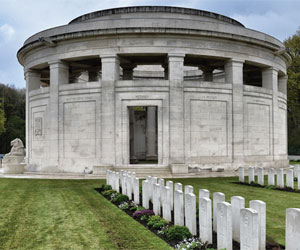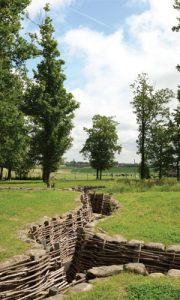The small city of Ypres in Flanders was once the centre of the European cloth trade. A pre-1914 guidebook described it as a ‘medieval gem’ in terms of its architecture, but during the four years of the Great War it became a symbol of sacrifice – the great British bastion on the Western Front.
By the close of the conflict more than 250,000 British and Commonwealth soldiers had died at Ypres; one in four of Britain’s casualties in the whole war, and roughly one in three of those who died on the Western Front.

Gas was first used here in 1915 and it later saw the introduction of the fearful Mustard Gas in 1917. Extensive trenches were constructed by the spring of 1915 and there was two years of stalemate with no major battles; yet casualties continued on a daily basis, as the many cemeteries testify to today.
One of the war’s most symbolic battles was fought here – Passchendaele – producing those almost standard images of the Great War: vast crater zones, and a muddy, mangled battlefield. In 1918 the German advance was once again stopped here and some of the first American troops in action took part in the final battle, when tanks, aircraft, artillery and infantry all working together finally ended the stalemate in Flanders.
A true insight
Our new Flanders Fields tour looks at these fascinating aspects of the war around Ypres, by taking some old favourites and adding in many of the new sites rapidly opening in the lead up to the centenary of the Great War in 2014. We start at the newly-renovated In Flanders Fields Museum, which has not featured in our programme for some years.
The new museum is excellent, leading the visitor through the background of the war, the first days of fighting in Belgium and the formation of the Ypres Salient. There are many new exhibits on display and some amazing and engaging films.
WW1 archaeology features heavily and a display on the Yorkshire Trench and Dugout ties in nicely with one of our later visits. In fact, there is so much to see, we have put aside most of a morning to spend here, followed by a proper daytime look at the Menin Gate, looking at its background, architecture and history, and the whole commemoration of the missing.

Real stories
Harry Patch was the ‘Last Fighting Tommy’. On the tour we follow his story and see where he fought and a new memorial to him on the battlefield where he served in 1917. Trenches also feature heavily in the tour, from the newly-constructed trench system at Zonnebeke where the evolvement of British and German trenches can be seen, to the preserved remains of Yorkshire trench to the fascinating Bayernwald trenches, a place where Hitler served in 1914.
Everything in detail
High ground and its possession and repossession by both sides is the key to understand the battles in Flanders and we look at the Messines Ridge and the huge mining offensive there, seeing some of the mine craters, including the largest mine fired at St. Eloi – more than 95,000 pounds of explosive! We also go up Kemmel Hill – the highest point in Flanders – and reflect on the price paid for the battles in Flanders during the Great War.
This new tour enables us to concentrate on a popular battlefield location, look at locations in some detail, honour the veterans and visit new sites which offer us a fascinating insight into what the war in the trenches of Flanders was really like.
By Paul Reed, Leger’s Head Battlefields Guide
